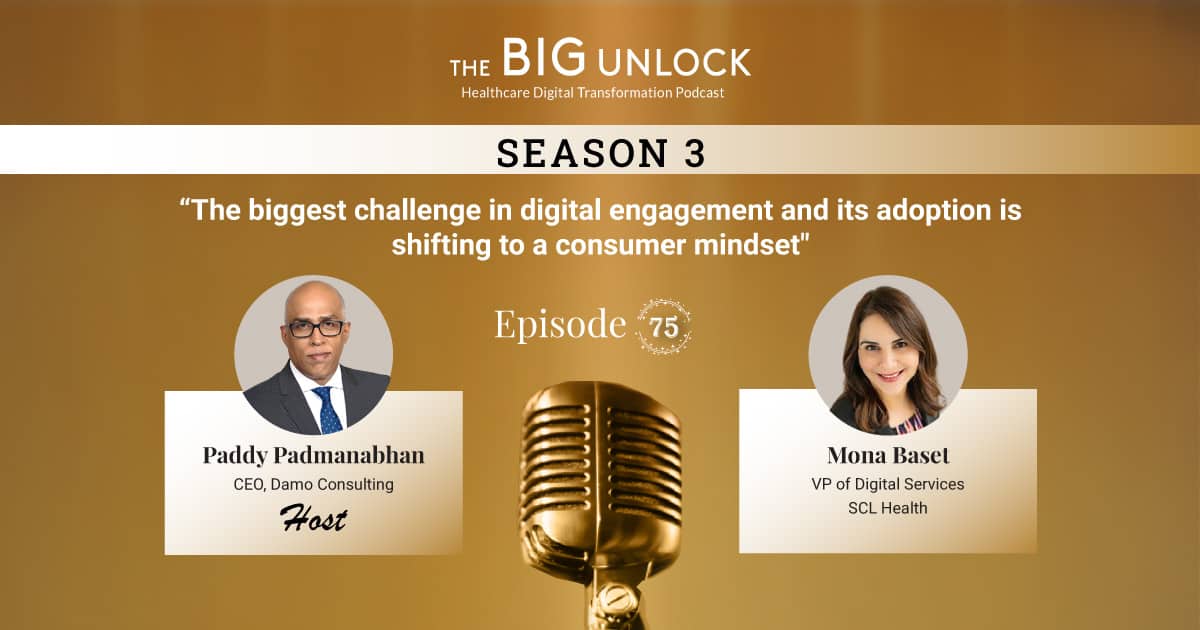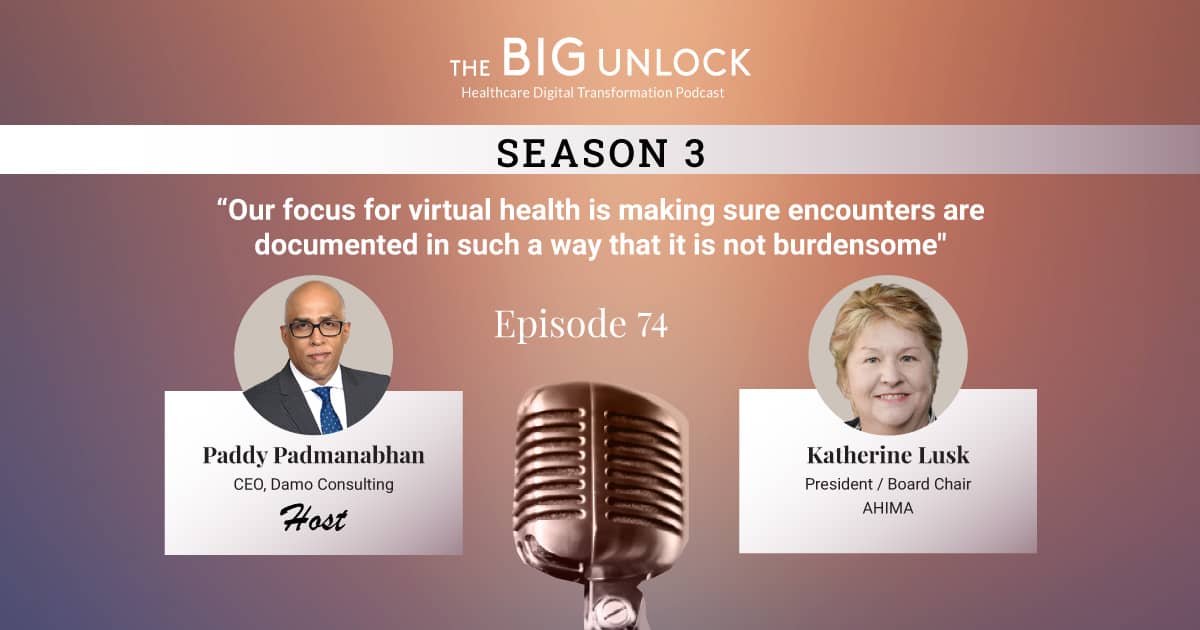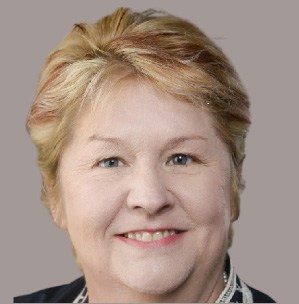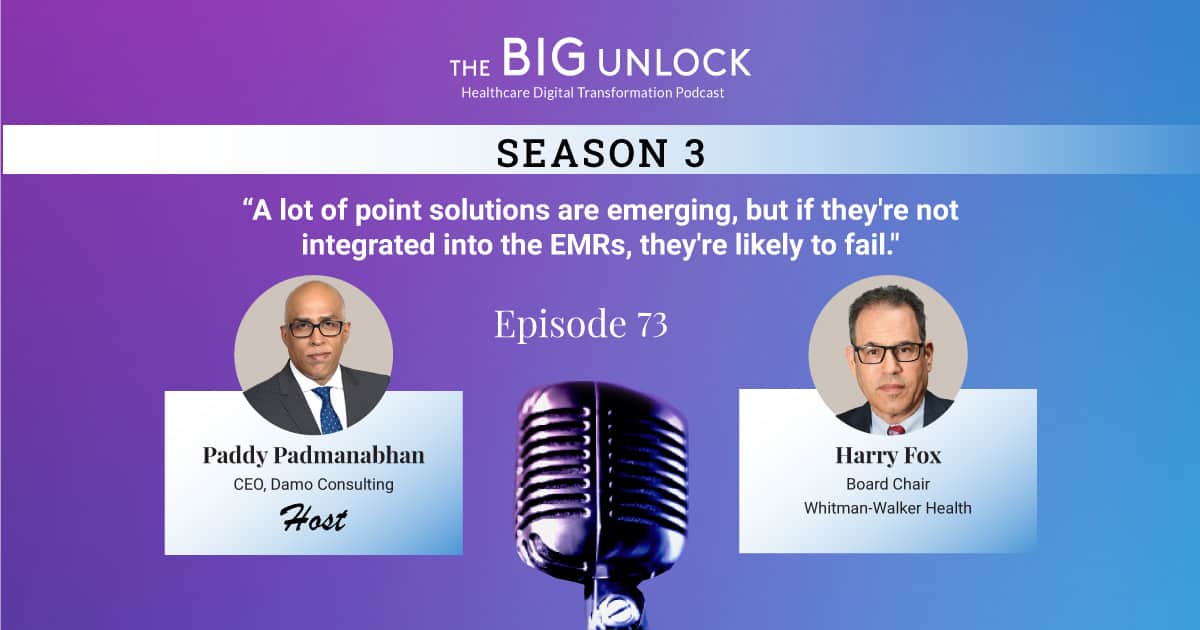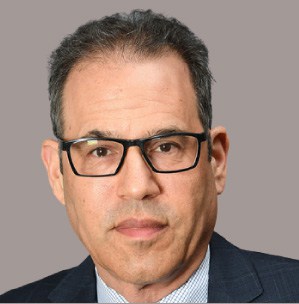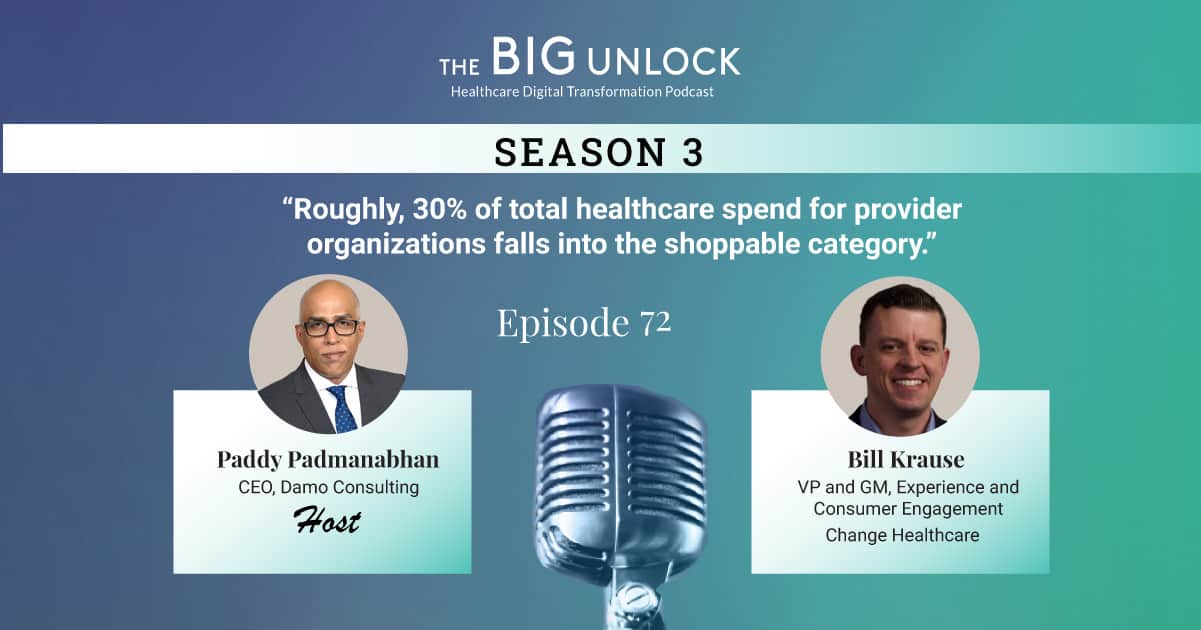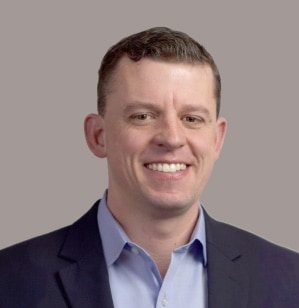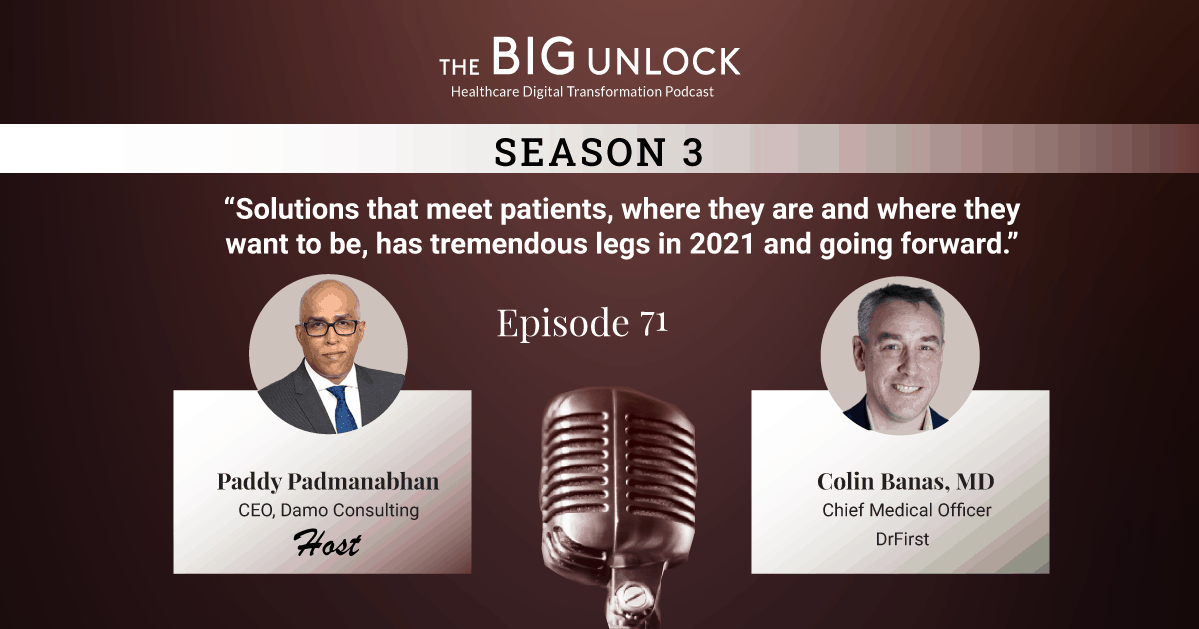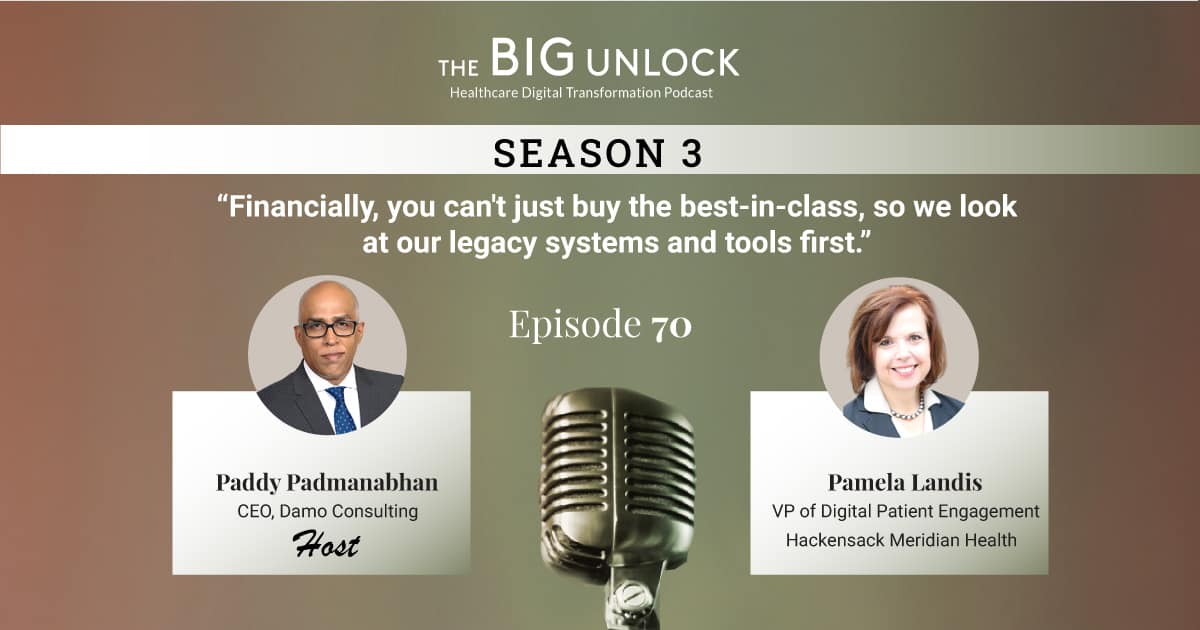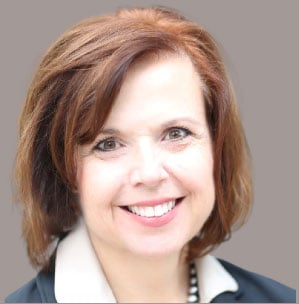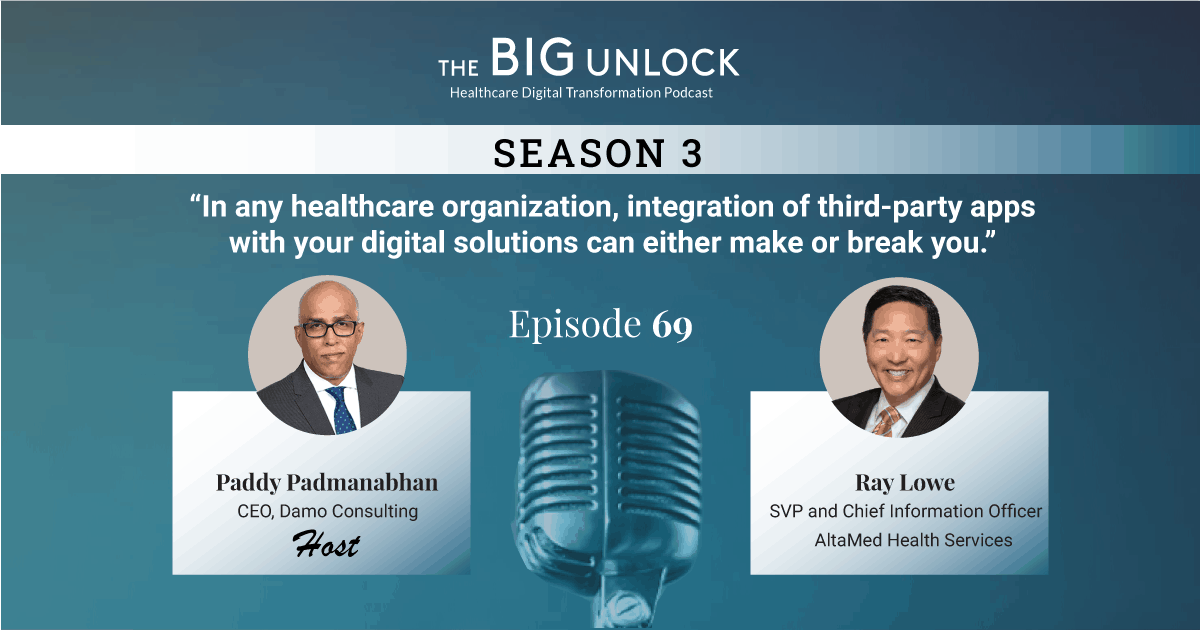Season 3: Episode #75
Podcast with Mona Baset, VP of Digital Services, SCL Health
"The biggest challenge in digital engagement and its adoption is shifting to a consumer mindset"
 Hosted by Paddy Padmanabhan
Hosted by Paddy Padmanabhan 
Share
In this episode, Mona Baset discusses how SCL is transforming its digital capabilities to provide a seamless digital patient experience just like other industries – retail, travel, and financial services.
According to Mona, one of the biggest challenges in adopting digital engagement is shifting to a consumer mindset. Health systems are now increasingly focusing on their digital front door initiatives. However, one of the biggest challenges in building a robust consumer app is incorporating both outside and native foundational capabilities, and bringing together a single native app.
SCL is a non-profit healthcare system and focuses on patient engagement and technologies to enable better patient experience. Take a listen.
Q: Tell us about SCL health, your role as the VP of Digital engagement, your responsibilities, and who the role reports to.
Mona: SCL health is a faith based non-profit healthcare system. We’re based in the Denver metro area, and primarily serve Colorado and Montana. SCL Health provides care across eight hospitals, more than one hundred clinics, and areas such as home health and hospice, mental health, and safety net services. My role as the Vice President of Digital Services was a newly formed position when I joined and it is part of the information technology and digital services organization here. I report to our Chief Information Digital Officer, but I really find that my role straddles a few different worlds – technology, marketing, consumer experience, engagement, associate engagement, and innovation. I get to work with a lot of incredibly talented people across all those areas. My team primarily focuses on engagement and the technologies that help enable those experiences. They are responsible for everything from our external website to our internet site, digital marketing and automation platforms, application development, and user experience. There are some new areas as well where we’ve begun to explore and implement like arts and robotic process automation. We find that when people have different ideas or things that they want to do or explore, oftentimes those ideas start with my team and then we can sort of assess them and figure out how to move forward.
Q: Can you walk us through some of the initiatives that you’ve rolled out in the last year and a half, especially in the areas of digital front door marketing and digital patient engagement?
Mona: When I arrived at SCL Health, we had a basic level of digital capabilities in place. We had MyChart, external website intranet, an older CRM instance, and virtual care capabilities. There was a lot of room for improvement to create that wonderful experience for patients, consumers, and even our own associates. We did a quick assessment of the current tools and some basic customer journey mapping. Once that information was laid out, it was easy to see where the gaps were and what we needed to put in place to fill those gaps. We did some prioritization exercises and some mapping exercises after generating some interesting ideas. What we really wanted to do was to deliver an experience that was similar to what consumers are expecting in other industries like retail, travel, and financial services.
We organized the efforts into four streams. One of those work streams is customer relationship management. In that area, we rolled out a new implementation of Salesforce Health Cloud and Marketing Cloud. We finished that up very recently. We are also looking at call center tools and consumer contact center transformation. Underneath that workstream, we are rolling out some different capabilities around automated communications to patients and consumers through text and email and phone.
The second workstream is what we’re calling digital workforce. If you think about that area, it’s really some of the automated tools and processes that we can put in place. For example, chatbots would fall in that area. So, we’ve rolled out a few different types of chatbots focused on different capabilities so consumers and patients can get the answers they need right away without having to wait to talk to someone. We’re also exploring some robotic process automation to help us become more efficient on the backend.
The third workstream is about associate tools. Currently, we have a very large-scale project underway to completely redesign re-platform our internet site for our associates and our providers. That will be rolled out mid-year. We are also looking at different ways to communicate among our associates, some HR focused tools and technologies.
The final workstream we are focused on is consumer and patient experience. This is where you find things like our external website, which we’re constantly improving and updating. That’s where you find MyChart optimization. We rolled out a brand-new provider directory to help people search for providers and schedule really easily. And this is also where we’ve been partnering with our innovation team to roll out a new consumer app that is actually rolling out next week. We’re super excited about that. It’s going to give our patients and consumers a really nice, streamlined way to access our services and information.
Q: With regards to consumer engagement and your role, what do you see as the big challenges in digital engagement and adoption?
MB: Healthcare no longer gets a pass on consumer experience. People are comparing their experiences with healthcare to their best experiences in other industries, and they’re expecting more now. I think the biggest challenge in our industry is really shifting to a consumer mindset. This is something that I think was slowly happening. COVID really accelerated that journey.
For example, prior to COVID, virtual care was available here, but it was slow to be adopted by our providers and our patients alike. When there was really no other option for care at certain points in this pandemic journey, we went from under one hundred video visits a month to thousands and thousands of video visits immediately. Now both providers and patients have experienced sort of the new way of doing things. They can see the ease and convenience and the effectiveness, and they see that they can get things done in the healthcare space, in a virtual way.
While we may not see the huge numbers that we saw at the very beginning, when there was really no other options for care, we will see this virtual care continue. Even after COVID isn’t part of our every thought and conversation, challenges of getting things rolled out while keeping that consumer mindset as a technology organization for healthcare system remains. Our job is really to support that acceleration toward consumerism and put on the table everything we know and everything we can learn to make that happen. We have to take that knowledge and not only be technologists, but we also have to be salespeople and we have to be marketers to be able to show our internal stakeholders and our patients how much better it could be for them.
Q: What are some of the biggest challenges that you faced when it comes to preparing yourself for this emerging virtual care era and digital engagement you just described?
MB: From a career perspective, I essentially grew up in marketing and many years in consumer financial services. When I made that transition to technology a few years ago, the consumer was always the starting point and the end point for me. We’re really taking that approach and are focused on how we can deliver care safely and effectively. We’re offering more types of virtual care than ever before and we’re listening to consumers. We have a patient family advisory council approach that we take and we connect with these patients and their families regularly to understand what they’re going through, what their journey is, how can we adapt to meet those needs? What additional engagement channels can we offer to really empower them to take control of their health journey? And I think so many things are involved in building that strong brand and that high level of consumer engagement is certainly key. The word, or the phrase digital front door is an interesting one, because it almost suggests that there’s just one door, but there are many doors. Our website is one of the digital front doors, our consumer app is another. So, we’re really trying to provide options and as we look at how our website functions, we’re looking at how are consumers expecting to engage with us? What do they expect to find there? And we’re trying to make improvements across the board so they can find information quickly. They can self-service, they can reach out to us if they need more help and just really giving them that full experience.
Q: From a technology choice standpoint, do you start with a bit of capabilities that are available in your system or do you start with a blank sheet of paper and look at what the best-in-class tools are out there and recommend and implement the ones that make the most sense from an impact standpoint?
Mona: I think a little bit of both. We have as an organization, five strategic platforms that we focus on and they really serve as solid foundation for our work. We have Epic for our EHR, Google for communications within our organization, Salesforce, Oracle ERP that’s going to be launching in April, and ServiceNow for internal types of requests. We try to start there and in many cases we have to consider additional capabilities. Obviously, these are very foundational and only do certain things. So we look at both. We are looking at some guiding principles that we use when we’re making technology choices. We want to be sure that we make experiences easy and low effort and want to focus on the user and their needs, not our processes. We want to leverage the small number of connected platforms that are needed, because it’s just much easier to manage. We also want to personalize experiences based on deep knowledge of our users, and we want to provide options to engage with us. We start with our foundational platforms and then when we decide to bring in other tools. Sometimes we do bring in sort of those proven best-in-class big tech solutions.
We’ve brought in a lot of others that are more in startup mode and they may ultimately become best-in-class. I think about some of the recent work we did to completely rebuild our provider directory on our website and all of the chatbot technologies we’re introducing. So, for those we partnered with what I consider to be smaller, really innovative companies that are nimble and creative and just offer solutions that are very unique and partner with us really well. We can almost co-develop solutions with them and it’s worked out great.
Q: When you talk about startups, there could also be risky bets. For instance, what if they run out of money from the venture capitalists or they lose their key individuals because they’re a small team. Have you ever had to plan for that kind of a situation, or have you had to actually live through one of those?
Mona: Thankfully, we have not. We know that is certainly a risk. These organizations are much more willing to partner with us to give us exactly what we need and really fitting into our budgets. As a not-for-profit, we don’t have huge budgets. So, it is a tradeoff and we have not experienced anything yet. We have taken those risks and have been able to deliver some interesting capabilities. I’m pretty happy about that and proud that we have really been able to partner with some great organizations to do so.
Q: How are you leveraging your internal datasets, patient histories and how are you combining that with externally available data sets? What is the framework you’re applying and the infrastructure you’re investing in order to harness the data, and improve and deliver the kind of experiences that the marketplace is looking for?
Mona: Data analytics is such an interesting topic these days. We have so much data out there. I would say it is truly at the heart of the work we do in digital engagement. Epic is our source of record for patient information. We don’t try to recreate that. I know other organizations have sort of challenges with some of that, but we really leverage that data as much as possible so that we truly know our patients. We can customize communications and touch points to them. I will say that in any digital project we have launched, data piece takes the longest. It’s the most complex and requires a lot of thought about data models and how integrations are going to work for our CRM implementation. We spent a lot of time building the right data model and integrations just to ensure that we have the most accurate and recent data available to help engage with our patients. If that information is not correct, then you are not engaging in a way that patients find useful. We are working on a similar project around expanding some automated communications to patients like those who are discharged from hospital. We’re spending a lot of time to make sure data is perfect so that the messages we’re sending makes sense and are relevant.
Q: When you talk to your peers across other health systems, what are some of the best practices? Can you share one that you’ve either adopted from one of your peers or one that one of your peers may adopt from your own experience?
Mona: As I look at what some of my most innovative peers are doing at other health systems, I’ve seen some really interesting implications and tools. I think COVID is top of mind. Some of those COVID related innovations have been pretty incredible, everything from vaccines management to screenings. One of the things I’ve seen more and more health systems working on is delivering on that consumer app approach, what might be called the digital front doors. They’re doing a great job at that. The best ones are addressing one of the biggest challenges in building a robust consumer app, that is, to have a plan for how any new capabilities, including those that might be offered by many different vendors, are brought together seamlessly for the consumer in a single native app. Sometimes your foundational platform just can’t deliver everything and you’re going to have to go outside of that and bring in other capabilities. But how do you make that invisible to the consumer so that they feel that they are just dealing with one organization, one tool, and they’re able to see everything?
I think as far as other best practices go and something we’re exploring and hope to make a best practice is really the use of artificial intelligence, patient engagement. When a consumer or patient doesn’t need to talk to a person and in many cases they don’t want to, they just want to be able to get things done themselves using chatbots and other artificial intelligence, and that’s a good thing for them. We try to leverage some of that and roll things out quickly, especially early on in COVID. So, we rolled out a chat that would allow people to learn more about COVID, take a risk assessment. It really reduced the anxiety that consumers had about COVID and reduce the number of anxious phone calls that came into our care sites, in our clinics. We’ve used similar technology to screen associates before work for COVID symptoms to keep them safe and our patients safer. Recently, we launched some additional chat technology on our website to answer key questions and information that consumers and patients have. We can change that on a daily basis. If we find that people are asking a lot about vaccines, for example, we can do that. So, we hope that will become a best practice going forward.
Q: Do you primarily rely on externally developed solutions for assembling this whole consumer experience? Are there pieces that you take complete ownership of, for instance, the mobile piece, if you do that internally and then have all of the embedded components behind the scenes come from different sources, or are you really looking at buying it all off the shelf where in that continuum are you?
Mona: I think it’s a little bit of both and sort of a hybrid. For example, with our CRM implementation, we purchased a solution for that and implemented it. Our internal team takes that over and maintains it and enhances it, similar to what we’ll be doing with our new consumer mobile app. We partnered with an organization to help us build that from scratch. Then we will be taking on the maintenance, the enhancements going forward. So, I think it’s a little bit of both. In some cases it makes sense for us to be able to have the autonomy to build on a platform and be able to be very flexible with improvements, enhancements in many cases.
Show Notes |
||||
| 09:35 | Biggest challenge in digital engagement and its adoption is shifting to a consumer mindset. | |||
| 11:03 | Technology organizations for healthcare systems must support virtual care acceleration toward consumerism | |||
| 13:34 | The phrase digital front door is an interesting one; it almost suggests that there's just one door. But of course, there are many doors. | |||
| 22:11 | Sometimes your foundational platform just can't deliver everything and you're going to have to go outside of that and bring in other capabilities. | |||
About our guest
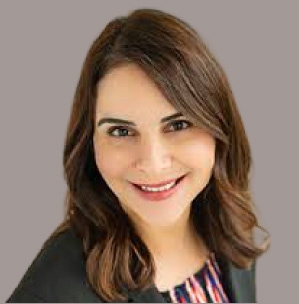
As Vice President of Digital Services at SCL Health, Mona Baset leads digital strategy and transformation, including development and implementation of the digital technology road map. Prior to joining SCL Health, Mona was Assistant Vice President in the technology organization at Atrium Health, leading consumer engagement strategies.
Previously, Mona spent almost 10 years at Bank of America, where she led various marketing and communications teams. Mona holds a bachelor’s degree in English from the University of California at Irvine, a master’s degree in Communications from Cal State Fullerton, and a master’s degree in Business Administration from Wake Forest University.
Recent Episodes
About the host
Paddy is the co-author of Healthcare Digital Transformation – How Consumerism, Technology and Pandemic are Accelerating the Future (Taylor & Francis, Aug 2020), along with Edward W. Marx. Paddy is also the author of the best-selling book The Big Unlock – Harnessing Data and Growing Digital Health Businesses in a Value-based Care Era (Archway Publishing, 2017). He is the host of the highly subscribed The Big Unlock podcast on digital transformation in healthcare featuring C-level executives from the healthcare and technology sectors. He is widely published and has a by-lined column in CIO Magazine and other respected industry publications.

